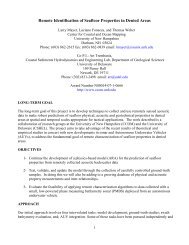Manufacturing Spec Sheet - AUVAC
Manufacturing Spec Sheet - AUVAC
Manufacturing Spec Sheet - AUVAC
You also want an ePaper? Increase the reach of your titles
YUMPU automatically turns print PDFs into web optimized ePapers that Google loves.
Vehicle Control Technologies, Inc.<br />
Proven Hydrodynamic Solutions<br />
from Simulation to Fabrication<br />
Contact<br />
1900 Campus Commons Dr. Ste. 300<br />
Reston, Virginia 20191<br />
Phone: 703·620·0703<br />
Email: info@vctinc.com<br />
Web: www.vctinc.com
Technologies And products<br />
www.vctinc.com<br />
PTB<br />
UUV<br />
UDS<br />
MISSION<br />
Long known for its hydrodynamic maneuvering simulations and undersea control systems, VCT<br />
is now delivering turnkey UUVs, Gliders, Powered Tow Bodies (PTB), and towed sonar vehicles.<br />
Drawing upon its design and simulation experience with over 350 vehicles, VCT is currently developing<br />
a series of modular UUVs. Standardized electronic and mechanical components as well<br />
as open-architecture core software make these modular vehicles exceptionally reliable and inexpensive<br />
to maintain.<br />
VCT’s Advantage in the vehicle marketplace is that it incorporates its high fidelity physics based<br />
M&S capabilities throughout the design and fabrication phases. This allows us to design in an<br />
environment rich in numerical & graphical analysis using high-productivity design tools. It also<br />
stimulates innovation, enlists cooperation within design teams, find errors early in the vehicle<br />
development cycle, lowering risk by conducting Hydro/Control simulations before hardware is<br />
available. VCT’s design approach supports DDR&E’s System 2020 vision “Application of modeling<br />
and simulation throughout the development process fosters more effective concept engineering<br />
and concurrent design, development, manufacturing, deployment and evolution.”<br />
Hydro Modeling & Simulation<br />
Validated simulation for both undersea and air vehicles<br />
Used to design vehicle shapes, towed systems and vehicle controllers<br />
Software<br />
Flexible, modern, open architecture software<br />
ASTM F-41 Architecture, SAE AS-4 JAUS messaging<br />
95% of VCT core software common across all vehicles<br />
Vehicle-specific parameters in a separate .ini input file<br />
Certification hours accumulate with each new vehicle<br />
Standard Linux operating system with 2.6 kernel<br />
16 new vehicles currently in design (Tested 10 vehicles in 2009-10<br />
Hardware/Underwater Vehicles<br />
The hydrodynamic, control and software simulation capability enables VCT to design and fabricate<br />
underwater vehicles that are more reliable, with modular hardware, field replaceable components,<br />
with an affordable upgrade path to do new missions. Standardizing key vehicle components across<br />
vehicle sizes and types enables rapid development cycle
www.vctinc.com<br />
VCT Family of<br />
Underwater Vehicles<br />
VCT has developed its line of underwater vehicles in a modular<br />
fashion that allows them to be configured as a UUV,<br />
glider or towed vehicle.<br />
VCT E-1 PC-104 Stack<br />
Contains all vehicle control electronics:<br />
CPU, Serial-12, IMU, Environmental,<br />
Remote Admin, Power, Pwr Distribution (2)<br />
Universal Tailcone:<br />
Contains all vehicle moving parts:<br />
Actuators, shaft and bearings, propeller,<br />
motor, motor controller<br />
Standardizing key vehicle components across vehicle<br />
Diameter and Functions enables rapid development<br />
Powered Tow Body TM<br />
VCT has designed its Powered Tow Body (PTB) for mine hunting, oceanographic, ISR and ASW<br />
missions. The PTB is an ideal low risk test bed for UUV subsystem development (energy & high<br />
value sensors).The PTB is a towed UUV with propulsion applied from both the towing craft and<br />
the on-board UUV’s propulsion. By varying the UUV thrust, a loop is formed in the cable, which<br />
reduces tow craft induced motions by 80%, which in turn, permits Synthetic Aperture Sonar (SAS)<br />
operation in sea state from an 11 meter RHIB. By power sharing with the host vehicle, mission<br />
endurance is significantly increased. Other features include increased power for payloads and<br />
real-time data back to host ship.<br />
SYSTEM SPECS<br />
Diameter: 12.75”<br />
Length: 87”- 140”<br />
Weight: 280 lbs<br />
Depth: 1000ft<br />
Max Speed:<br />
UUV 12-14 Kts<br />
PTB 7 Kts<br />
Propulsion: 1.8 kW<br />
IMU: HG-1700/3DM-GX1<br />
Tracking: USBL<br />
Depth and Altitude Sensors<br />
Noise <strong>Spec</strong>: None<br />
Locating System: Emergency Pinger<br />
Lightweight integrated LARS with Universal Docking<br />
System (UDS) for UUV, Glider and PTB launch and recovery.<br />
UUV design adapts to PTB for low risk T&E of UUV components<br />
No impact on UUV design objectives<br />
On deck change-over in 30 min for 12.75” vehicle<br />
Currently being used in prototype risk reduction testing for LDUUV
www.vctinc.com<br />
VCT Family of<br />
Underwater Vehicles<br />
xGlider TM<br />
VCT has developed its line of underwater vehicles<br />
in a modular fashion that allows them<br />
to be configured as a UUV, glider or towed<br />
vehicle. Because of VCT’s modular components,<br />
our gliders can be upgraded to hybrid<br />
vehicles allowing the use of the UUV function<br />
when speeds above 2 kts are critical (heading<br />
into currents) and the glider function when<br />
quietness is critical, all in the same mission.<br />
Vehicle Command & Control<br />
& Autopilot Systems<br />
Several advances in glider design expand the<br />
CONOPS for glider use. The key advance include<br />
removal of the wing and replacement<br />
of the shifting roll and pitch masses with actuated<br />
external fins. The xGlider has an endurance of 2 to 10 months depending on the glider size and<br />
battery type chosen by the Customer. This design is capable of transecting ocean currents of 2 knots,<br />
exceeding legacy glider capabilities by a factor of 4. All components are depth rated to 1000 meters in<br />
order to maximize its navigability. Baseline xGlider outperforms legacy systems in speed and turning<br />
diameter. VCT’s xGlider removes most, if not all the shortcomings with legacy gliders and UUV’s.<br />
UUV Glider<br />
VCT’s vehicle software architecture is based on the ASTM F-41 international standard. It is open,<br />
object-oriented, scalable and applicable across all of the vehicles of interest in this community.<br />
The same VCT software is currently being used in 16 different UUV’s, gliders, and towed vehicles.<br />
References are available upon request. Flight hours from any vehicle using VCT’s vehicle software<br />
translate to increased reliability and robustness across all vehicles.<br />
In order to facilitate the use of VCT’s software on many different vehicles, key aspects of the software<br />
such as autopilot, device, and Vehicle Controller configuration are stored in configuration files, not<br />
hard-coded in the source.<br />
Integration of new sensors, autonomy modules, and command and control is facilitated by the<br />
object-oriented design of the vehicle software and its adherence to the ASTM F-41 architecture.<br />
Software robustness is assured through well-defined software development processes and thorough<br />
testing. Software testing includes both automated and manual testing at all scales from unit<br />
testing to full vehicle SITL, PITL, and HITL testing.<br />
VCT engineers combine aero/hydrodynamic engineering and software design work into a single,<br />
seamless process. Our software development utilizes the latest compilers, configuration<br />
management, issue tracking, and continuous integration software to produce robust and reliable<br />
vehicle software.
www.vctinc.com<br />
Unmanned Underwater Vehicle (UUV)<br />
VCT’s UUV is available in diameters from 6.5” to 15” and a wide range of vehicle lengths. The<br />
same standardized hardware and software is used for all vehicle sizes. When the buoyancy engine<br />
is added to the UUV, it can operate as a UUV and a glider on the same mission. Changing out the<br />
nose section converts the UUV to a powered tow body (PTB).<br />
Universal Docking System (UDS)<br />
Docking of the UUV with the LARS is a key component of automated recovery. VCT has developed<br />
the Universal Docking System (UDS), a towed system that enables the autonomous underwater<br />
capture of a UUV. UDS has been demonstrated on a 12 ¾” UUV.<br />
Operator Console<br />
The operator’s console (OC) is used to communicate with the all the vehicles. The OC provides an<br />
interface through which status and health of all the systems can be monitored. In the context of an<br />
UUV, the OC is used to update mission plans prior to launch as well as track its position relative to<br />
the surface craft and UDS during the recovery phase. For a towed vehicle or PTB, the operator console<br />
enables the operator to monitor health and status of the vehicle at all times and to continuously<br />
monitor vehicle and control system outputs (pitch, roll, heading, fin deflections, RPM, etc.).<br />
Current R&D<br />
Interests/Projects<br />
VCT is currently developing the Towed Air Vehicle (TAV) system under an SBIR program.<br />
The purpose of the system is to provide an aerial communications relay for USV line of sight<br />
communications. The current prototype will demonstrate powered towed flight from the VCT test<br />
boat and communications relay.<br />
VCT’s physics based modeling and simulation capabilities, its vehicle control expertise, modular<br />
software and autopilot capabilities, along with its modular hardware uniquely positions it to develop<br />
an integrated autonomy system for USV/UUV/PTB applications. Progress to date includes:<br />
Unmanned surface vehicle (USV)<br />
VCT’s 36 ft RV has been outfitted with an all digital control system for propulsion rpm and rudder<br />
control and is ready for integration of the PTB, LARS, smart winch software for a completely<br />
autonomous mission capability.<br />
Powered Tow Body (PTB)<br />
PTB was demonstrated at TRL-6 level in September 2010.<br />
Launch and Recovery System (LARS)<br />
VCT’s light weight LARS for 12 3/4” UUV/PTB as well as a hybrid LARS for either a 12 3/4 “ or 21”<br />
UUV/PTB has been in service at VCT for the past 18 months.<br />
Smart Winch<br />
A component of the PTB motion reduction approach is the Smart Winch. It provides additional motion<br />
compensation topside and has a controller that communicates with other vehicles or systems<br />
on the network. This allows PTB-related autonomy software to command and control the surface<br />
craft, winch, and the PTB vehicle in order to support completely autonomous UUV/PTB missions.
www.vctinc.com<br />
COMPANY HISTORY<br />
Founded in 1993 by Dr. Douglas Humphreys and Mr.<br />
Kenneth W. Watkinson, Vehicle Control Technologies,<br />
Inc. (VCT) is a valued member of vehicle design teams<br />
at Navy shipbuilders, weapon system prime contractors<br />
and Navy laboratories. The VCT team continues a commitment<br />
to excellence and service spanning more than<br />
40 years – 30 years in the private industry (Titan Research<br />
& Technologies) and 10 in the Navy laboratory system.<br />
VCT is a small business with 22 employees, having started<br />
as a transition of personnel and technology from the<br />
ARAP group of Titan Research and Technologies.<br />
LARS with Smart Winch<br />
Hybrid<br />
Surface Craft<br />
MANAGEMENT TEAM<br />
Dr. Douglas E. Humphreys, President<br />
Dr. Humphreys is a senior consultant to both industry and government agencies, primarily on U.S.<br />
Navy research projects in dynamics and control, simulation, and design of both hydrodynamic<br />
and aerodynamic vehicles. He has conducted research, design and analysis of the dynamics and<br />
control of numerous underwater vehicles, performing studies and simulations on the four newest<br />
U.S. fleet submarines and control surface design concepts for the SSN 21 and the new Virginia<br />
class. He has performed design studies covering concept formulation, feasibility analyses,<br />
preliminary design, detailed design and experimental validation on a wide variety of undersea<br />
vehicle systems including AQS-20 Towed Sonar Vehicle and Mk 30 Target Vehicle. 80% of those<br />
applications have been for vehicles with unique or novel geometries, where no previous experimental<br />
data were available. He has conducted the design or analysis of over 350 underwater and<br />
air vehicles, and he has authored more than 200 technical reports.<br />
Dr. Thomas F. Tureaud, Vice President<br />
Since 1994, he has been a Senior Design Engineer at Vehicle Control Technologies, Inc. Dr. Tureaud<br />
manages the underwater development group that includes four Mechanical Engineers and<br />
four Electrical Engineers. At VCT, he has been involved with over 30 designs for underwater systems.<br />
These include an UXO underwater search vehicle; the AQS20 towed system, an automated<br />
docking and launch and recovery system, and several UUV and towed vehicles. He is partner on<br />
two patents, has several patents pending, and is currently the Vice President at VCT.
Contact<br />
1900 Campus Commons Dr. Ste. 300<br />
Reston, Virginia 20191<br />
Phone: 703·620·0703<br />
Email: info@vctinc.com<br />
Web: www.vctinc.com<br />
Vehicle Control<br />
Technologies, Inc.


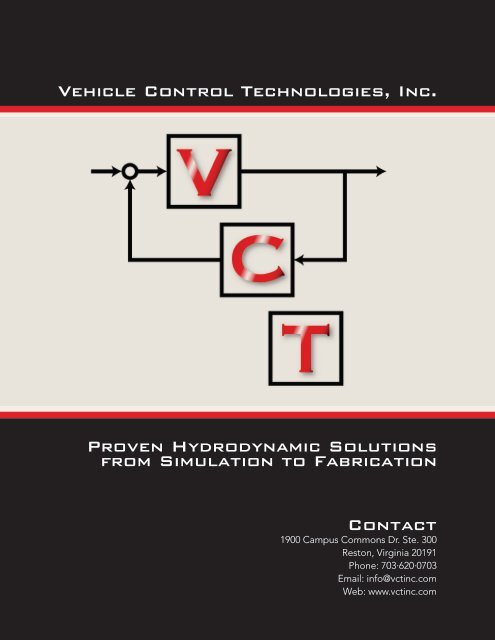
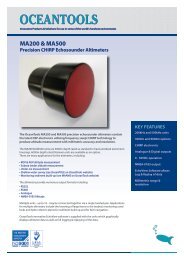

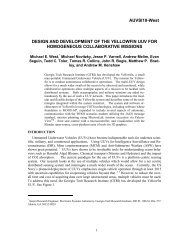
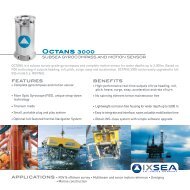
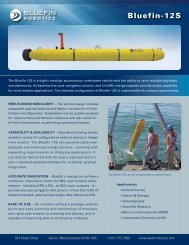
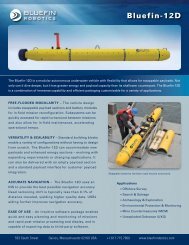


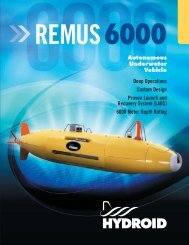


![Sonardyne Wideband Sub-Mini 6 [8270, 8271].pdf - AUVAC](https://img.yumpu.com/44408971/1/190x245/sonardyne-wideband-sub-mini-6-8270-8271pdf-auvac.jpg?quality=85)


